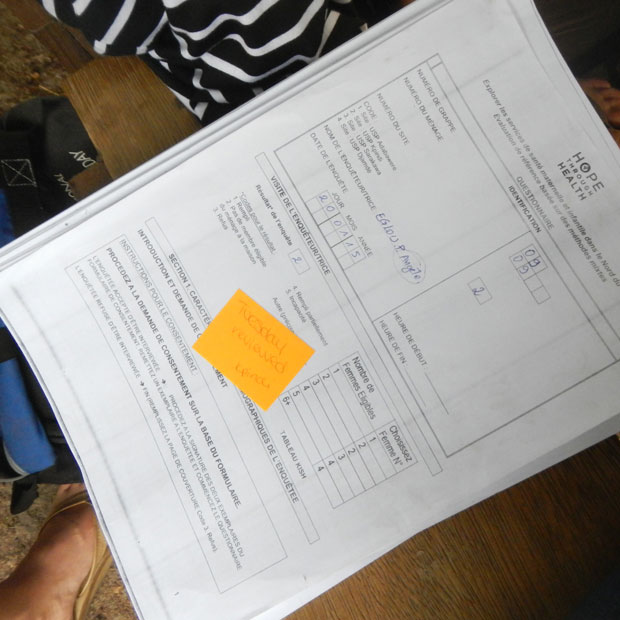Throughout my time in Togo, my focus has been on setting up systems for quality data collection to help foster a culture of analysis. When we are collecting high-quality data consistently and correctly, program managers and the monitoring and evaluation team have access to the data they need, and can spend their time investigating potential places for quality improvement in the health services we offer rather than getting stuck trying to clean up and make sense of bad data. Upgrading from paper surveys to electronic data collection for this year’s Maternal and Child Health (MCH) survey fit into that framework, and it was pretty exciting to see what a difference our new tools made at every step of the way.

A stack of last year’s paper surveys. They were 18 pages each! Photo courtesy of Alicia
The main benefit of upgrading from paper was decreasing the amount of missing or unusable data we collected. On this year’s electronic survey we used data validation code to limit the possible answers to certain specific choices, so that data collectors were forced to choose “yes” or “no” to a question like “have you ever been to school” instead of leaving it blank or writing in an answer that was not one of the choices and therefore couldn’t be used. Similarly, on questions where data collectors could choose “doesn’t know”, the form could prompt them to try harder to get a response, or give them tips for figuring out the answer. These were a major source of missing data in the 2015 survey that were eliminated in 2016.
Another benefit of the electronic survey was eliminating incorrect code mistakes. In order to facilitate data entry, our 2015 paper survey required data collectors to convert word answers (like “yes” or “no”) into their corresponding numerical codes (1 or 2) to record on the form. There was always a chance that the data collectors would write down the wrong code, but with an electronic survey they could just check the box next to the word answer that the respondent chose, making the data recording process more user-friendly.

The electronic survey on one of our new tablets! Photo courtesy of Alicia
Perhaps the biggest way that the electronic survey became more user-friendly was that the tool does the decision-making about which questions to display for each respondent depending on their previous answers. For example, some questions are only relevant for women who have given birth in the past two years, or women with a child under five years old, but our paper surveys had to include every question, so the data collectors needed to reason to figure out which to fill out and which to leave blank. There was a lot of confusion about these different sections, which led to data collectors often wasting their time by filling out irrelevant sections, or accidentally skipping over important questions.
Finally, digital data collection eliminated the need for data entry, which means that there was no longer a space for data to be lost or corrupted between data collection and entry due to bad handwriting or typing mistakes.
An exciting added benefit was getting instant statistics. At the end of each day of data collection we could instantly see statistics like how many surveys were conducted and what our daily response rate was, which helped us adjust our data collection strategy from day to day.
Now that the survey is over, our data is all ready to be analyzed, and we can go back to the health center staff as well as the communities we surveyed to deliver reports and suggestions almost immediately after completing the research.

Me attaching a car charger to the motorcyle battery for charging our tablets. Photo courtesy of Alicia
Of course, there were challenges with adapting to the new system, but nothing insurmountable. For example, the most difficult part at the beginning was figuring out how to charge our tablets in remote villages without electricity. We tried a couple options, including fitting a car charger to my motorcycle to charge tablets while I drove around, but we ended up finding places to pay to charge at each village, whether by solar panel or gas-powered generator or a modified motorcycle engine like my own. It turns out that even in the most remote villages, many people have cell phones that need charging, so you can usually find someone who has set up shop to make this possible off the grid and make a profit off of it.

The generator used to power a cell tower in one of our villages. The cell service provider’s employee who looks after the generator and antenna siphons off a little power to charge people’s phones, at 15 cents per charge. Photo courtesy of Alicia




